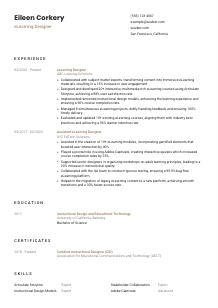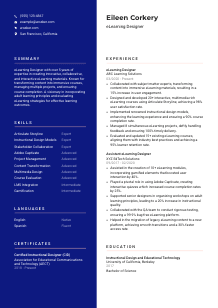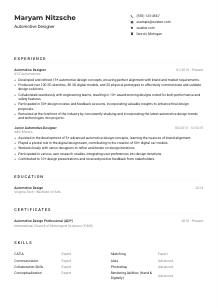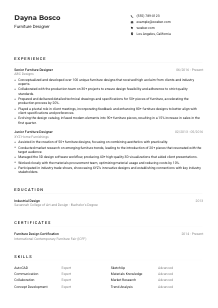eLearning Designer Resume Example
Shaping digital knowledge, but your resume feels offline? Dive into this eLearning Designer resume example, crafted with Wozber free resume builder. Grasp how you can match your virtual teaching talents to job specifics, ensuring your career trajectory stays online and on top!
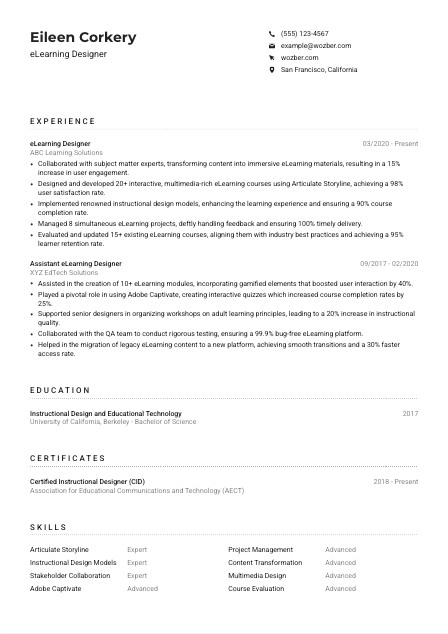
How to write an eLearning Designer resume?
Hey there, aspiring eLearning visionary! If you're keen to sculpt an eLearning Designer resume that not only ticks all the boxes but truly resonates with hiring managers, you're in the right place. By leveraging the power of Wozber, including its free resume builder, ATS-friendly resume templates, and ATS resume scanner, this guide serves as your beacon.
Ready to craft a resume that showcases your digital teaching talents as vividly online as they do in action? Let's turn your career aspirations into achievements!
Personal Details
First impressions last, making your Personal Details section pivotal. Let's ensure it's a handshake that resonates, tailored perfectly for the eLearning Designer position, by following these dedicated steps.
1. Highlight Your Name Boldly
Your name is essentially your brand. Highlight it with confidence, utilizing a noticeable, readable font. This is where you own your identity as an eLearning Designer, setting the stage for your narrative.
2. Align With Your Aspired Role
Directly beneath your name, proudly state your aimed title, ‘eLearning Designer'. This signals to the hiring manager right away that your expertise is precisely what they've been searching for.
3. Ensure Your Contact Information is Clear
Offer your most reliable phone number and a professional email address. A simple format, like firstname.lastname@email.com, goes a long way in keeping things professional and accessible.
4. Location Matters
Given the role's specific need for a San Francisco base, indicating your city and state as ‘San Francisco, California' places you a step ahead by fulfilling one of the key logistical requirements.
5. Add a Professional Link
If applicable, your LinkedIn profile or professional portfolio is a welcome addition. Ensure it's polished and mirrors your resume, serving as an extended insight into your professional world.
Takeaway
Your Personal Details section is more than just administrative trivia; it's the first note of your professional symphony. Craft it with the care it deserves, ensuring it sings in harmony with the eLearning Designer role you're aspiring for. You're setting the stage for an impactful first impression!





Experience
The Experience section is where your resume gets down to business, highlighting your journey and successes as an eLearning Designer. Let's ensure each accomplishment resonates with the specific job description provided.
- Collaborated with subject matter experts, transforming content into immersive eLearning materials, resulting in a 15% increase in user engagement.
- Designed and developed 20+ interactive, multimedia‑rich eLearning courses using Articulate Storyline, achieving a 98% user satisfaction rate.
- Implemented renowned instructional design models, enhancing the learning experience and ensuring a 90% course completion rate.
- Managed 8 simultaneous eLearning projects, deftly handling feedback and ensuring 100% timely delivery.
- Evaluated and updated 15+ existing eLearning courses, aligning them with industry best practices and achieving a 95% learner retention rate.
- Assisted in the creation of 10+ eLearning modules, incorporating gamified elements that boosted user interaction by 40%.
- Played a pivotal role in using Adobe Captivate, creating interactive quizzes which increased course completion rates by 25%.
- Supported senior designers in organizing workshops on adult learning principles, leading to a 20% increase in instructional quality.
- Collaborated with the QA team to conduct rigorous testing, ensuring a 99.9% bug‑free eLearning platform.
- Helped in the migration of legacy eLearning content to a new platform, achieving smooth transitions and a 30% faster access rate.
1. Decode the Job Description
Begin by dissecting the job description, identifying key phrases and requirements. Look for specifics, like 'collaborate with SMEs' or 'design interactive eLearning courses', that directly relate to past roles.
2. Present Your Journey Clearly
Structure your experience in reverse chronological order. For each role, include your title, company name, and dates of employment, laying the groundwork for your achievements to shine.
3. Craft Achievement-Focused Statements
Detail your responsibilities and achievements in a way that mirrors the job requirements. For instance, if the job mentions 'collaborating with SMEs', highlight how you've excelled in this area, backed by tangible outcomes like ‘resulting in a 15% increase in user engagement'.
4. Quantify Your Success
Numbers speak volumes. Quantify your achievements wherever possible, be it through user engagement metrics, the number of courses developed, or project management successes, making your impact concrete and measurable.
5. Relevance is Key
Keep the spotlight on experiences that weave directly into the narrative of an eLearning Designer. Each bullet point should serve as a testament to why you're not just a fit but the ideal candidate for the role.
Takeaway
Your Experience section is a powerful narrative of your professional journey. By tailoring it with precision, aligning with the job's demands, and quantifying your accomplishments, you transform this section into persuasive evidence of your suitability and readiness for the challenge ahead. Let your experience speak volumes!
Education
The Education section is your chance to showcase the academic foundation that has prepared you for a role as an eLearning Designer. Let's make sure it reflects your qualifications in alignment with the job requirements.
1. Identify Key Requirements
Pinpoint what the job asks for in terms of educational background – in this instance, a 'Bachelor's degree in Instructional Design, Educational Technology, or a related field'. This will be the cornerstone of your education section.
2. Structure with Clarity
Maintain a clean layout for your education details. Start with your degree, followed by the field of study, then the university name, and finally, the graduation date.
3. Match the Job's Specifications
Ensure your listed degree directly matches the job's requirements. If you hold a Bachelor of Science in Instructional Design and Educational Technology, for instance, you've hit the nail on the head.
4. Mention Relevant Courses
While not always necessary, highlighting specific courses that hone in on key job requirements can add depth to your qualifications, especially if you're at the early stages of your career.
5. Celebrate Educational Achievements
Any accolades, honors, or specific projects that align with the eLearning Designer role should be briefly included. This shines a spotlight on your dedication and achievements within your field.
Takeaway
Your education says a lot about you – not just in terms of your degree but also the dedication, passion, and hard work you've invested in your chosen field. Present it in a way that aligns with the eLearning Designer position, letting it serve as robust proof of your qualifications. Your education section is more than a credential; it's a pillar of your professional story.
Certificates
In the fast-evolving field of eLearning, certifications can be your ace in highlighting ongoing professional development. Let's navigate how to present them in a way that complements your experience and draws a direct line to your suitability for the eLearning Designer role.
1. Filter Relevant Certifications
Start with a selective approach. Highlight certifications like ‘Certified Instructional Designer (CID)' that underscore your expertise and align with the job description. This signals a commitment to your profession and its best practices.
2. Prioritize Based on Job Alignment
While you may have multiple certifications, prioritize those most relevant to the job at hand. Quality over quantity ensures the hiring manager immediately sees the value you bring.
3. Date Your Achievements
For certifications with validity periods or those recently attained, adding the date shows recency and relevancy, keeping the hiring manager informed of your current capabilities.
4. Keep Your Certifications Updated
The realm of eLearning is perpetually advancing. It's crucial to not only list your certifications but to seek out new ones, staying at the forefront of instructional design innovation and methodology.
Takeaway
Certifications are a testament to your eagerness for continuous improvement and learning within the eLearning domain. Skillfully selected and presented certifications offer a compelling narrative of your commitment to excellence and lifelong learning. Keep evolving and let your certifications be the milestones that narrate your journey!
Skills
Your Skill section is a concise showcase of the tools you wield to make eLearning magic happen. From hard skills like mastery in 'Articulate Storyline' to softer ones like 'Stakeholder Collaboration', let's fine-tune this section to highlight your prowess.
1. Unpack the Job Description
Begin by identifying both explicit and implicit skills in the job description. Keywords like 'Proficiency with eLearning authoring tools' and 'Excellent communication skills' are your cues.
2. Reflect and Match
Assess your own skill set and match it against the job's demands. If 'Adobe Captivate' is mentioned and you're adept at it, list it. Ensure your skills mirror the requirements as closely as possible.
3. Prioritize for Impact
While it's tempting to list every skill under the sun, prioritization is key. Focus on the skills that pack the biggest punch, are most relevant to the position, and demonstrate your unique value proposition.
Takeaway
Think of your Skills section as the highlights reel of your professional capabilities. Curate it meticulously to ensure each skill listed strikes a chord with the job description and reinforces your candidacy as the eLearning Designer of choice. This is your chance to succinctly communicate the essence of your professional offering. Shine bright!
Languages
In the world of eLearning, the ability to communicate across linguistic barriers can be a significant edge. Let's explore how to effectively showcase your language skills, emphasizing their relevance to the global eLearning landscape.
1. Survey Job-specific Language Needs
Initially, check if the job posting highlights language preferences. For our eLearning Designer role, 'Must possess strong English language skills' was specified, making it a priority to list.
2. Prominently Feature Required Languages
English, being a stipulated requirement, should sit at the top of this section, marked as 'Native' or 'Fluent', as appropriate, to instantly align with the set expectation.
3. Showcase Additional Languages
Beyond the essentials, additional languages you're proficient in could add unique value, especially in roles that envisage creating learning materials for a global audience. It demonstrates an added layer of versatility.
4. Be Clear About Proficiency
Use distinct terms like 'Fluent', 'Intermediate', or 'Basic' to accurately represent your language skills. This transparency builds trust and sets clear expectations about your communication capabilities.
5. Consider the Role's Global Outlook
If the role involves international collaboration or content creation for varied demographics, emphasize your multilingual skills. It hints at your potential to seamlessly blend into global teams and cater to diverse learner bases.
Takeaway
Your mastery of languages is a passport to global opportunities in the eLearning space. Display it with pride but with precision, reflecting your true capabilities. Whether it's designing courses for international learners or collaborating across borders, your language skills can be the bridge to untapped opportunities. Let them shine as a testament to your global readiness.
Summary
Your resume's Summary section is your opening narrative – a compelling blend of your skills, experience, and the unique flair you bring to the eLearning domain. Let's craft it to resonate powerfully with the job at hand, drawing the hiring manager's interest right from the start.
1. Digest the Role
Absorb the essence of the job description, identifying key functionalities and expectations. This will serve as your guideline, ensuring your summary directly addresses the needs of the role.
2. Start Strong
Kick off with a dynamic introduction that encapsulates your professional persona and proven track record, 'eLearning Designer with over 5 years of expertise…'
3. Highlight Key Competencies
Zero in on skills and accomplishments that align with the job's demands. Mention your proficiency with tools like 'Articulate Storyline', your knack for 'collaborating with SMEs', and any quantifiable achievements that underscore your impact.
4. Be Concise Yet Powerful
Aim for brevity, but pack it with punch. Your summary should be a crisp, powerful teaser, enticing hiring managers to dive deeper into the narrative of you as the ideal eLearning Designer.
Takeaway
Your Summary isn't just an introduction; it's your chance to assert why you're not only a fit but the perfect candidate for the eLearning Designer role. Tailor it meticulously, making every word count towards showcasing your prowess and vision in the eLearning landscape. Let it invite hiring managers into your story, compelling them to learn more about the powerhouse that is you.
Launching Your eLearning Designer Journey
Congratulations on crafting an eLearning Designer resume that's not just ATS-compliant but a vivid reflection of your talent and dedication. Remember, this document isn't just paperwork – it's your narrative, your introduction to the world, and a key to unlocking your career aspirations. Armed with insights from Wozber's free resume builder, ATS-friendly resume template, and ATS resume scanner, you're well on your way to opening new doors. So set your sights high, let your resume be your beacon, and step confidently toward your next big eLearning adventure!

- Bachelor's degree in Instructional Design, Educational Technology, or a related field.
- Minimum of 4 years experience in eLearning design and development.
- Proficiency with eLearning authoring tools such as Articulate Storyline and Adobe Captivate.
- Strong understanding of instructional design models, adult learning principles, and multimedia design.
- Excellent communication and project management skills.
- Must possess strong English language skills.
- Must be located in or willing to relocate to San Francisco, CA.
- Collaborate with subject matter experts (SMEs) to gather content and transform it into engaging eLearning materials.
- Design and develop interactive, multimedia-rich eLearning courses using industry-leading software.
- Implement instructional design strategies to enhance the learning experience and meet organizational goals.
- Manage multiple eLearning projects simultaneously, ensuring timely delivery within budget.
- Regularly evaluate and update existing eLearning courses to ensure alignment with best practices and learning outcomes.





